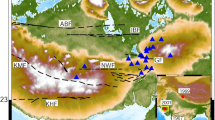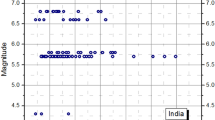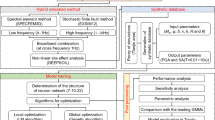Abstract
In this study, seismic attenuation model is derived using recorded and simulated ground motions covering the data gap region of the Indo-Gangetic Plains (IGP), employing artificial neural networks (ANN) methodology. Four independent variables moment magnitude (Mw), focal depth, epicentral distance (Repi), and average shear wave velocity up to 30 m depth (Vs30) are selected to predict peak ground acceleration (PGA) and pseudo-spectral acceleration (PSA) (5% damping) between periods 0.01 to 4 s (twenty-five periods in total), utilizing 926 recordings (PESMOS, CIGN and synthetic database). A feed-forward ANN with Levenberg–Marquardt training algorithm is employed for training the network of input and output dataset. The optimal network architecture obtained in this study consists of 4–9–26 input, hidden and target nodes, respectively. In spite of the absence of presumed functional dependencies in ANN methodology, our model captured a number of sound physical features of earthquake ground motion: magnitude scaling, attenuation with distance and radiation damping. Further, the performance of the model is measured by the standard deviation of the error, σ(ε), and compared with the four widely used conventional GMPEs applicable for IGP region of India. The standard deviations for our model varied between 0.208 and 0.263 which is less than the classical GMPEs at all twenty-six periods of PSA. Finally, the ANN model performance is compared with recorded ground motions at four stations and conventional GMPEs, and the results affirm that this model is competent to predict the response spectrum with good accuracy for IGP region.











Similar content being viewed by others
Availability of data and material
ANN model in Excel and MATLAB script is attached as supplementary material along with the manuscript.
Code availability
Not applicable.
References
Abrahamson NA, Silva WJ, Kamai R (2014) Summary of the ASK14 ground motion relation for active crustal regions. Earthq Spectra 30:1025–1055
Ahmed I, El Naggar MH, Khan AN (2008) Neural network based attenuation of strong motion peaks in Europe. J Earthq Eng 12:663–680
Anbazhagan P, Kumar A, Sitharam TG (2013) Ground motion prediction equation considering combined dataset of recorded and simulated ground motions. Soil Dyn Earthq Eng 53:92–108
Baruah S, Gogoi NK, Erteleva Q, Aptikaev F, Kayal JR (2009) Ground Motion parameters of Shillong plateau: one of the most seismically active zones of Northeastern India. Earthq Sci 22:283–291
Beale MH, Hagan MT, Demuth HB (2017) Neural Network Toolbox™ User's Guide. The Mathworks Inc
Bilham R, Bodin P, Jackson M (1995) Entertaining a great earthquake in western Nepal: historic inactivity and geodetic tests for the present state of strain. J Nepal Geol Soc 11(1):73–78
Bilham R, Wallace K (2005) Future Mw> 8 earthquakes in the Himalaya: implications from the 26 Dec 2004 Mw= 9.0 earthquake on India’s eastern plate margin. Geol Surv India Spec Publ 85:1–4
Boore DM, Stewart JP, Seyhan E, Atkinson GM (2014) NGA-West2 equations for predicting PGA, PGV, and 5% damped PSA for shallow crustal earthquakes. Earthq Spectra 30:1057–1085
Bydlon SA, Gupta A, Dunham EM (2017) Using simulated ground motions to constrain near-source ground-motion prediction equations in areas experiencing induced seismicity. Bull Seism Soc Am 107:2078–2093
Campbell KW, Bozorgnia Y (2014) NGA-West2 ground motion model for the average horizontal components of PGA, PGV, and 5% damped linear acceleration response spectra. Earthq Spectra 30:1087–1115
Chadha RK, Srinagesh D, Srinivas D, Suresh G, Sateesh A, Singh SK, Pérez-Campos X, Suresh G, Koketsu K, Masuda T, Domen K (2015) CIGN, a strong-motion seismic network in central Indo-Gangetic plains, foothills of Himalayas: first results. Seismol Res Lett 87:37–46
Chiou BS, Youngs RR (2014) Update of the Chiou and Youngs NGA model for the average horizontal component of peak ground motion and response spectra. Earthq Spectra 30:1117–1153
Das S, Gupta ID, Gupta VK (2006) A probabilistic seismic hazard analysis of Northeast India. Earthq Spectra 22:1–27
Derras B, Bard PY, Cotton F, Bekkouche A (2012) Adapting the neural network approach to PGA prediction: an example based on the KiK-net data. Bull Seism Soc Am 102:1446–1461
Derras B, Bard PY, Cotton F (2014) Towards fully data driven ground-motion prediction models for Europe. Bull Earthq Eng 12:495–516
Derras B, Bard PY, Cotton F (2016) Site-condition proxies, ground motion variability, and data-driven GMPEs: insights from the NGA-West2 and RESORCE data sets. Earthq Spectra 32:2027–2056
Dhanya J, Raghukanth STG (2018) Ground motion prediction model using artificial neural network. Pure Appl Geophys 175:1035–1064
Frank IE, Todeschini R (1994) The data analysis handbook (vol 14). Amsterdam
Gandomi AH, Alavi AH, Mousavi M, Tabatabaei SM (2011) A hybrid computational approach to derive new ground-motion prediction equations. Eng Appl Artif Intell 24:717–732
Gupta ID (2010) Response spectral attenuation relations for in slab earthquakes in Indo-Burmese subduction zone. Soil Dyn Earthq Eng 30:368–377
Harbindu A, Gupta S, Sharma ML (2014) Earthquake ground motion predictive equations for Garhwal Himalaya, India. Soil Dyn Earthq Eng 66:135–148
Iyengar RN, Ghosh S (2004) Microzonation of earthquake hazard in greater Delhi area. Curr Sci 87:1193–1202
Iyengar RN, Raghukanth STG (2004) Attenuation of strong ground motion in peninsular India. Seismol Res Lett 75:530–540
Jain SK, Roshan AD, Arlekar JN, Basu PC (2000) Empirical attenuation relationships for the Himalayan earthquakes based on Indian strong motion data. In: Proceedings of the sixth international conference on seismic zonation, pp 12–15
Khandelwal M, Singh TN (2011) Predicting elastic properties of schistose rocks from unconfined strength using intelligent approach. Arab J Geosci 4:435–442
Khattri KN (1999) Probabilities of occurrence of great earthquakes in the Himalaya. Proc Indian Acad Sci-Earth Planet Sci 108(2):87–92
Kimiaefar R, Siahkoohi HR, Hajian AR, Kalhor A (2016) Seismic random noise attenuation using artificial neural network and wavelet packet analysis. Arab J Geosci 9:234
Kumar A, Mittal H, Sachdeva R, Kumar A (2012) Indian strong motion instrumentation network. Seismol Res Lett 83:59–66
Levenberg K (1944) A method for the solution of certain non-linear problems in least squares. Q Appl Math 2:164–168
Mai PM, Beroza GC (2000) Source scaling properties from finite-fault-rupture models. Bull Seism Soc Am 90:604–615
Mandal P, Kumar N, Sathyamurthy C, Raju IP (2009) Ground-motion attenuation from strong motion records of the 2001 Mw 7.7 Bhuj earthquake sequence (2001–2006), Gujarat. India Pure Appl Geophys 166:451–469
MATLAB (2018) Version R2018b. The MathWorks Inc., Natick, MA
McVerry GH, Holden C (2014) A modified ground-motion prediction equation to accommodate spectra of simulated Hikurangi subduction interface motions for Wellington. Consultancy Report 2014/131, GNS Science
Monjezi M, Bahrami A, Varjani AY, Sayadi AR (2011) Prediction and controlling of flyrock in blasting operation using artificial neural network. Arab J Geosci 4:421–425
Muthuganeisan P, Raghukanth STG (2016) Site-specific probabilistic seismic hazard map of Himachal Pradesh, India. Part I. Site-specific ground motion relations. Acta Geophys 64:336–361
Nath SK, Raj A, Thingbaijam KKS, Kumar A (2009) Ground motion synthesis and seismic scenario in Guwahati city; a stochastic approach. Seismol Res Lett 80:233–242
Nath SK, Vyas M, Pal I, Singh AK, Mukherjee S, Sengupta P (2005) Spectral attenuation models in the Sikkim Himalaya from the observed and simulated strong motion events in the region. Curr Sci 295–303
Nath SK, Vyas M, Pal I, Sengupta P (2005) A seismic hazard scenario in the Sikkim Himalaya from seismotectonics, spectral amplification, source parameterization, and spectral attenuation laws using strong motion seismometry. J Geophys Res Solid Earth 110(B1)
Nath SK, Thingbaijam KK, Maiti SK, Nayak A (2012) Ground-motion predictions in Shillong region, northeast India. J Seismol 16:475–488
NDMA (2011) Development of probabilistic seismic hazard map of India, Technical Report, Working Committee of Experts (WCE), National Disaster Management Authority (NDMA), New Delhi, India
Patnala VSN, Rajaram C, Ramancharla PK, Davuluri S (2017) Determination of geophysical parameters of himalayan region. In: Proceedings of the 16th world conference on earthquake engineering
Pozos-Estrada A, Gómez R, Hong HP (2014) Use of Neural network to predict the peak ground accelerations and pseudo spectral accelerations for Mexican Inslab and Interplate Earthquakes. Geofís int 53(1):39–57
Raghucharan MC, Somala SN (2017) Simulation of strong ground motion for the 25 April 2015 Nepal (Gorkha) Mw 7.8 earthquake using the SCEC broadband platform. J Seismol 21:777–808
Raghu Kanth STG, Iyengar RN (2007) Estimation of seismic spectral acceleration in Peninsular India. J Earth Syst Sci 116:199–214
Raghu Kanth STG, Kavitha B (2014) Ground motion relations for active regions in India. Pure Appl Geophys 171:2241–2275
Rajendran CP, John B, Rajendran K (2015) Medieval pulse of great earthquakes in the central Himalaya: viewing past activities on the frontal thrust. J Geophys Res Solid Earth 120(3):1623–1641
Rajendran CP, Rajendran K (2005) The status of central seismic gap: a perspective based on the spatial and temporal aspects of the large Himalayan earthquakes. Tectonophysics 395(1–2):19–39
Rezaei S, Choobbasti AJ, Kutanaei SS (2015) Site effect assessment using microtremor measurement, equivalent linear method, and artificial neural network (case study: Babol, Iran). Arab J Geosci 8:1453–1466
PESMOS Department of Earthquake Engineering, Indian Institute of Technology, Roorkee. http://pesmos.in. Accessed 7 May 2018
Peter A, Harald B, Wolfgang M (2008) A learning rule for very simple universal approximators consisting of a single layer of perceptrons. Neural Netw 21:786–795
Sharma ML, Douglas J, Bungum H, Kotadia J (2009) Ground-motion prediction equations based on data from the Himalayan and Zagros regions. J Earthq Eng 13:1191–1210
Sharma ML (1998) Attenuation relationship for estimation of peak ground horizontal acceleration using data from strong-motion arrays in India. Bull Seism Soc Am 88:1063–1069
Sharma ML (2000) Attenuation relationship for estimation of peak ground vertical acceleration using from strong motion arrays in India. In: Proceedings of the 12th World Conference on Earthquake Engineering, Auckland, New Zealand (vol 1964)
Sharma ML, Bungum H (2006) New strong ground motion spectral acceleration relation for the Himalayan region. In: Proceedings of First European conference on earth-quake engineering and seismology, pp 1459
Sharma ML, Haribhandhu A (2012) Strong Ground Motion Prediction Equation for Northwest Himalayan Region Based on Stochastic Approach. In: Proceedings of 15th World Conference of Earthquake Engineering, Lisbon
Sharma ML, Harbindu A (2014) Ground Motion Prediction in Himalayas Using Observed and Simulated Datasets. In: Proceedings of 10th US National Conference on Earthquake Engineering, Anchorage, Alaska
Shearer PM (2009) Introduction to seismology. Cambridge University Press, Cambridge
Singh RP, Aman A, Prasad YJJ (1996) Attenuation relations for strong seismic ground motion in the Himalayan region. Pure Appl Geophys 147:161–180
Singh SK, Srinagesh D, Srinivas D, Arroyo D, Pérez-Campos X, Chadha RK, Suresh G, Suresh G (2017) Strong Ground Motion in the Indo-Gangetic Plains during the 2015 Gorkha, Nepal, Earthquake Sequence and Its Prediction during Future Earthquakes. Bull Seismol Soc Am 107:1293–1306
Tavakoli H, Kutanaei SS (2015) Evaluation of effect of soil characteristics on the seismic amplification factor using the neural network and reliability concept. Arab J Geosci 8:3881–3891
Wald DJ, Allen TI (2007) Topographic slope as a proxy for seismic site conditions and amplification. Bull Seismol Soc Am 97:1379–1395
Wason HR, Sharma ML (2000) Source parameters study of local earthquakes in the Garhwal Himalaya based on the digital broadband data. In: Proceedings of 12th World Conference on Earthquake Engineering pp 1–6
Wolfgang M (1997) Networks of spiking neurons: the third generation of neural network models. Neural Netw 10:1659–1671
Acknowledgements
Authors thank Dr. D. Srinagesh, Chief Scientist, NGRI, Hyderabad, for sharing the recorded data of 25 April 2015 Nepal Earthquake. Authors also thank the anonymous reviewers for their thoughtful comments which have improved the quality of the manuscript.
Funding
Surendra Nadh Somala acknowledges the funding from DST Project INT/RUS/RFBR/P-335.
Author information
Authors and Affiliations
Corresponding author
Ethics declarations
Conflict of interest
The authors declare no any conflicts of interest or competing interests.
Additional information
Publisher's Note
Springer Nature remains neutral with regard to jurisdictional claims in published maps and institutional affiliations.
Supplementary Information
Below is the link to the electronic supplementary material.Ð
Rights and permissions
About this article
Cite this article
Raghucharan, M.C., Somala, S.N., Erteleva, O. et al. Seismic attenuation model for data gap regions using recorded and simulated ground motions. Nat Hazards 107, 423–446 (2021). https://doi.org/10.1007/s11069-021-04589-w
Received:
Accepted:
Published:
Issue Date:
DOI: https://doi.org/10.1007/s11069-021-04589-w




